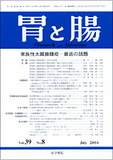Japanese
English
- 有料閲覧
- Abstract 文献概要
- 1ページ目 Look Inside
- 参考文献 Reference
要旨 症例は60歳の男性.家族性大腸腺腫症(FAP)の診断で約5,000個のポリポーシスと3個の進行癌を認め,1989年に全結腸直腸切除術・回腸肛門吻合が施行された.術後,上部・下部消化管のサーベイランスを行っていたところ,2001年から残存回腸の腺腫性ポリープの増加・増大傾向がみられ,内視鏡切除を行った.内視鏡切除後に出血による貧血を繰り返したため,ポリープの縮小を狙ってsulindac投与を行った.投与3か月後には回腸ポリープは著明に縮小し数も減少した.sulindacを暫減して投与継続し,ポリープはほぼ消失した状態を保ち特に副作用を認めていない.
A case of a sixty-year-old man who, in 1989, underwent total colectomy and ileo-anal anastomosis, because of polyposis involving thousands of polyps and three advanced cancers, under the diagnosis of familial adenomatous polyposis (FAP). After the surgical operation, annual surveillance examinations, such as esophago-gastro-duodenoscopy and ileo-anoscopy, were performed. In 2001, dozens of adenomatous polyps more than 5 mmin diameter, were observed in the J-pouch. Endoscopic resection was attempted twice, but bleeding from the resected site occurred and the patients serum hemoglobin level fell to below 10.0g/dl.
To control the ileal polyps, sulindac 300mg/day was administered. Three months after taking sulindac, ileo-anoscopy showed regression of the adenomatous polyposis. The patient is now well controlled and the dosage is gradually being reduced. Sulinduc therapy may be the first line therapy to procure regression of J-pouch adenomas.
1) Department of Internal Medicine, Cancer Institute Hospital, Tokyo

Copyright © 2004, Igaku-Shoin Ltd. All rights reserved.


